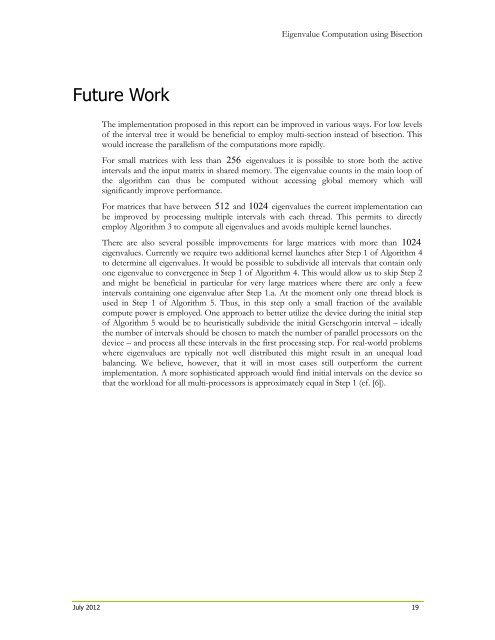Christian Lessig
SORtc
SORtc
- No tags were found...
You also want an ePaper? Increase the reach of your titles
YUMPU automatically turns print PDFs into web optimized ePapers that Google loves.
Eigenvalue Computation using Bisection<br />
Future Work<br />
The implementation proposed in this report can be improved in various ways. For low levels<br />
of the interval tree it would be beneficial to employ multi-section instead of bisection. This<br />
would increase the parallelism of the computations more rapidly.<br />
For small matrices with less than 256 eigenvalues it is possible to store both the active<br />
intervals and the input matrix in shared memory. The eigenvalue counts in the main loop of<br />
the algorithm can thus be computed without accessing global memory which will<br />
significantly improve performance.<br />
For matrices that have between 512 and 1024 eigenvalues the current implementation can<br />
be improved by processing multiple intervals with each thread. This permits to directly<br />
employ Algorithm 3 to compute all eigenvalues and avoids multiple kernel launches.<br />
There are also several possible improvements for large matrices with more than 1024<br />
eigenvalues. Currently we require two additional kernel launches after Step 1 of Algorithm 4<br />
to determine all eigenvalues. It would be possible to subdivide all intervals that contain only<br />
one eigenvalue to convergence in Step 1 of Algorithm 4. This would allow us to skip Step 2<br />
and might be beneficial in particular for very large matrices where there are only a feew<br />
intervals containing one eigenvalue after Step 1.a. At the moment only one thread block is<br />
used in Step 1 of Algorithm 5. Thus, in this step only a small fraction of the available<br />
compute power is employed. One approach to better utilize the device during the initial step<br />
of Algorithm 5 would be to heuristically subdivide the initial Gerschgorin interval – ideally<br />
the number of intervals should be chosen to match the number of parallel processors on the<br />
device – and process all these intervals in the first processing step. For real-world problems<br />
where eigenvalues are typically not well distributed this might result in an unequal load<br />
balancing. We believe, however, that it will in most cases still outperform the current<br />
implementation. A more sophisticated approach would find initial intervals on the device so<br />
that the workload for all multi-processors is approximately equal in Step 1 (cf. [6]).<br />
July 2012 19


